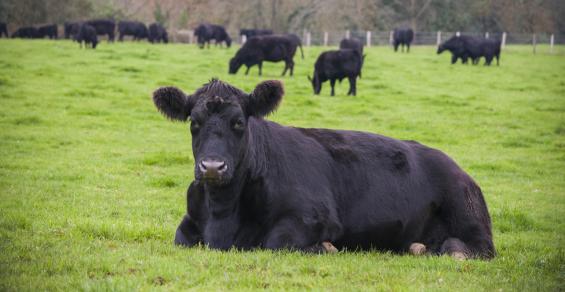The good news is that shallow compaction often caused by animals can be quickly resolved.
In my work as a grazing dairy farmer and now as a Cornell University Cooperative Extension educator working with grazers across New York, I am well aware of pasture soil compaction.
Permanent pastures for livestock can have some of the healthiest soils because they provide the four principles of healthy soil, as described by the Natural Resources Conservation Service: maximum soil cover, maximum living roots year-round, maximum plant and animal diversity, and minimal soil disturbance.
One weak spot for some pastures is soil compaction, which reduces the spaces between soil particles causing them to become denser. Theoretically, the space in a healthy soil aggregate is made up of 25% air; 25% water; 45% sand, silt or clay; and 5% organic matter. When compacted, the soil’s air and water portions are reduced so that biological functions, water retention and root elongation are reduced.
When the grazing season starts, livestock go into the pastures no matter the weather. If the soil is wet, it’s more prone to compaction.
The weight of an animal compared to the size of its hoof can exert more compaction than a tractor. Therefore, in the past, sheep were used to pack an area to create a dam.
Even though an animals’ compaction is great, it only shows up in the upper portion of the soil where it can be corrected over time. Compaction from a tractor goes deeper, and this can be more damaging in terms of overall soil health.
Repeating compaction over many years causes a very slow and damaging effect on the functions of the soil and the species that make up your grazing sward, reducing the productivity of the pastures.
What I have learned from a three-year Northeast Sustainable Agricultural Research and Extension-funded project is that although compaction is unavoidable, a change in management will quickly remedy it.
How the project started
While working on another SARE-funded study — planting brassicas into fall pastures to improve the nutrient density of fall swards — I noticed that the soil under the fence in one of our study paddocks was about 6 inches higher than in the pasture, and the sward under the fence was greener and had only cool-season grass compared to the paddock, which also had some weeds and sedges.
Knowing that sedges grow in oxygen-limiting soils, I realized that soil compaction was limiting the productivity of this pasture.
I also learned that compaction was furtive, meaning that it happened slowly over time. This change was hidden from the farmer, who was a good grazer and had farmed there for nearly 20 years.
This gave me the idea to investigate ways to monitor soil compaction for better pasture management.
Productivity is reduced when compaction is left for many years. Plants that live in compacted soils are not as productive because of the shallower roots and are often not palatable to the livestock.
A penetrometer can be useful to measure soil compaction. When pushed into the soil, it measures the soil’s resistance. Its meter indicates the pounds per square inch (PSI) of resistance at the tip.
The limitation of a penetrometer is that the resistance is highly affected by the changing moisture of the soil. A soil will have more, or less, resistance on different days as the soil dries out or becomes damp. This has precluded the penetrometer from being a reliable monitoring tool.
Developing the Pasture Compaction Ratio
I decided to develop a ratio that looks at the unique conditions of pastures where the soil is impacted by grazing animals in comparison to a pasture’s fence line, which is not affected by animals or machine-based compaction.
Here’s how I calculated the ratio:
Using a penetrometer, collect five readings (pounds per square inch) of the top 6 inches of the pasture. These are averaged to determine pasture resistance.
Divide the pasture resistance by the average of five readings collected under the fence line to determine fence line resistance.
Divide the fence line resistance number by the pasture resistance number to determine the Pasture Compaction Ratio.
Using this PCR, I looked for any change between the optimum compaction area — fence line — and the compacted area — pasture.
I selected a 35-acre pasture that was continuously overgrazed by 40 to 60 beef animals. There was increased traffic by the animals in this pasture as they got only small bites from the sward consisting of bluegrass, Dutch clover and other forbs.
Because of the declining productivity of this pasture, the animals in the trial mostly relied on stored hay brought into the pasture.
In November 2019, I installed a 10-foot-by-10-foot square enclosure in the pasture that excluded animal traffic. To mimic hay production within the enclosure, I cut the area to a 4-inch height twice during the season.
In 2019 and 2020, I took penetrometer readings of the enclosure and divided them into the fence line readings to arrive at the enclosure’s PCR. I continued to do the same for the pasture PCR.
Key takeaways
The pasture PCRs for 2019 and 2020 were similar, which was expected since there were no management changes.
In April of both years, the PCRs for both the pasture and enclosure started out the same. The rising pasture PCR after May 2020 shows that the pasture’s compaction resistance was improving since the PCR is moving closer to the fence line’s compaction PCR, which peaked at 1.0.
The separation of the 2020 pasture compaction ratios for the pasture and enclosure show that the use of the PCR is good for monitoring management changes. The switch to hay production within the enclosure reduced the compaction of the soil.
I expected that the reduction in compaction in the enclosure would have shown up in April 2020 because of the frost and the heaving of the soil. The fact that the compaction reduced after May might be a result of increased soil temperatures and biological activity causing the soil’s air and water spaces to expand.
I can’t explain why the 2020 PCRs for pasture and enclosure deviated in August. Why did they both drop? It was suggested that the one measurement I failed to track was soil moisture. I assumed that moisture would change equally, but if the pore spaces increase as the soil is less compacted, that soil would have more water in those pores.
The reduction in compaction in the enclosure happened within a few months. What didn’t change was the makeup of the sward — bluegrass and other low-production species — brought about by years of compaction in the pasture. Therefore, it is important to monitor compaction and change management before the sward species change.
The most interesting takeaway from this study is how quickly the shallow compaction in the pastures dissipated. The real damage was caused in pastures where the management did not change and the years of compaction reduced the function of the soil so that it changed the grazing sward to less-productive species.
Much more study is needed to better understand the usefulness of using a ratio between two soil management areas as a monitoring technique. This project raises a lot more questions about creating a reliable PCR tool.
Developing a way to monitor soil compaction with a readily available tool would provide a great tool to farmers and advisers who want to improve the function and health of agricultural soils.
To learn more about the technical details of the PCR study, visit scnydfc.cce.cornell.edu.
How to reduce pasture compaction
As mentioned earlier, compaction in pasture soil is unavoidable. Here are some suggestions to reduce compaction on your pasture and grazing lands:
Graze mature swards. Benefits include deeper roots, longer rest periods and denser bites so that the animal fills with fewer footsteps.
Know the soil texture of your pastures. Soils high in sand and silt are more prone to compaction. Try to graze when soil is dry. A healthy texture would be equal amounts of sand, silt and clay.
Track your organic matter. Higher organic matter makes stronger soil aggregates or particles.
Vary the use of paddocks where possible. For example, start your grazing in different paddocks each spring, and then allow the paddocks to be harvested for hay throughout the season.
For more tips, see “Pasture Soil Compaction: Prevention and Remediation” at projects.sare.org.
Benson is a small dairy support specialist with Cornell Cooperative Extension of Cortland County.





